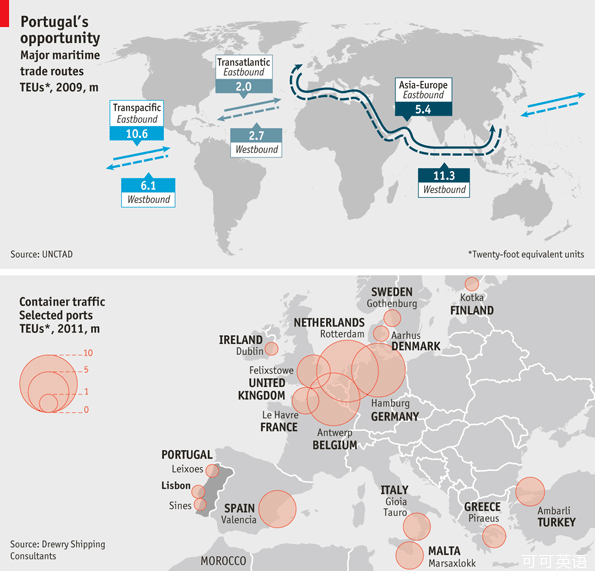Finance and Economics;Building euro-zone competitiveness;Ports in the storm;
財經;加強歐元區競爭力之;暴風雨中的港口;
Portugal needs to privatise its ports to reap the full benefits of its location. The latest in our series on reforming Europe's economies
葡萄牙應將港口私有化以完全發揮其區位優勢。歐洲經濟改革系列之最新進展
Lisbon's harbour mixes pleasure with business. Bars and restaurants sit alongside industrial machinery and colossal container ships. The combination works: shiny cranes gleam in the sunset as tourists and locals eat and drink at the water's edge. But Portuguese ports are a less happy blend of private and public control. The newish government is set to take a fresh look at ports as part of a wider programme of IMF-mandated structural reforms. What should it do?
里斯本(葡萄牙首都)港的商業氛圍中不乏歡快。酒吧和餐館就坐落于工業機械和龐大的集裝箱船旁邊。這是一種奇妙的搭配:夕陽中,游客和本地人在水畔邊吃邊喝,起重機則在落日的余暉中閃閃發光。但是葡萄牙由私人經營的和政府掌控的港口搭配在一起,就顯得不那么有情調了。新一任政府準備好以新的眼光來看待港口,要將其當做IMF主導的結構性改革更廣泛項目的一部分。接下來應該做些什么呢?

Passing through seaports can be expensive, accounting for a big chunk of goods' wholesale costs. Price-sensitive shippers will seek out prime ports, looking for value, speed and reliability. Port efficiency is in turn linked to ownership structure.
船只穿越海港的花費占貨物批發成本中的很大一部分,代價高昂。對價格敏感的運貨商很看重港口的價值,速度以及可靠性,將會物色主要港口。而港口效率與所有權結構則息息相關。
In general, private-sector involvement improves things. Typical benefits include shorter queuing times, cheaper container unloading, longer opening hours and higher capacity utilisation. Until 1984, Portugal's ports sat at the state-controlled end of the ownership spectrum (much of the country's aviation infrastructure still does). Since then, they have gradually moved to an intermediate public-private “landlord” model. This can work well: the government owns the land and water access, while private firms finance, build and operate tugboats, cranes and warehouses.
一般而言,私人部門參與進來會起到改善作用。典型的好處包括能縮短排隊等候時間,降低集裝箱卸貨價格,延長港口開放時間以及增加設備使用率。直到1984年,葡萄牙的港口的所有權結構還位于所有權譜1的國有控制一端(這個國家的大多航空基礎設施現在依然如此)。后來,這種結構逐漸演化為位于中間位置的公-私‘共同所有'模型。這一結構能夠較好地起作用:政府擁有土地和水路,私有公司則負責購買,修建并經營拖船,起重機和倉庫。
This liberalisation process has made Portuguese ports better—investment has increased capacity and productivity has improved. But further improvements are needed, according to Rui Marquez and Carlos Cruz of the Technical University of Lisbon, if Portugal is to compete effectively for container ship business.
這一自由化進程使得葡萄牙港口發展得更好——投資增加了其吞吐容量,生產力也得到了改善。里斯本技術大學的瑞馬吉是和卡洛斯克魯茲認為,如果葡萄牙想要在集裝箱船業有效競爭的話,還需要采取更多的改進措施。
These ships keep on getting bigger. The bulkiest vessels can carry 14,000 twenty-foot containers—a cargo that would require a train 85km (53 miles) long if transported by rail. The result is huge economies of scale: the cost per container on an Asia-to-Europe trip has fallen from around $1,000 to below $300, according to one study.
這些船變得越來越大。最大的船能夠裝載14000個兩英尺長的集裝箱——若用鐵路運輸同樣的貨物得需要長85千米(53英里)長的火車。這是巨大的規模經濟的結果:據一項研究表明,亞洲至歐洲船運的單位集裝箱成本已經從1000美元左右降至300美元以下了。
Big ships will stop at only four or five destinations in Europe, raising the stakes for ports trying to win their custom, according to Neil Davidson of Drewry Shipping Consultants. To lure them, ports need deeper harbours and bigger cranes to unload the cargo. They also need to offer an attractive onward route to final customers. This can be overland using trucks, or by sea if the port offers connections with lots of smaller ships. For Portugal, this means competing to serve the cities of Seville and Malaga by lorry or train, or acting as a shipping hub by battling with rival ports in Spain and Morocco.
德魯里航運咨詢公司的尼爾戴維森認為,大船在歐洲只會選擇四五個目的地停靠,這增加了港口努力贏取大船惠顧的不確定性。為了吸引他們,港口需要有更深的港灣和更大的起貨設備來卸貨。同時港口也要為以此港為終點的顧客提供一套令人心動的前行路線。這可能包括利用卡車走陸路,或者是走海路,但前提是港口能夠提供與許多更小船只的連接手段。這對葡萄牙而言意味著他要與西班牙和摩洛哥的對手港口競爭,通過卡車或火車競相為塞維利亞(西班牙地名)和馬拉加(西班牙南部省)提供服務,或者是充當一個海運中心。
Portugal should be well-placed to compete. Its coast is right on the enormously busy Asia-Europe shipping route (see map). Its highest-capacity container port—Terminal XXI at the Port of Sines—can handle the biggest ships. It is well within reach of southern Spain, with onward rail and road connections that have been made much better in recent years. But despite improvements between 2009 and 2010, the port is still a minnow by European standards. To make further gains, especially in the ultra price-sensitive transshipment market, Portugal needs to steer past two obstructions: powerful service providers and unionised workers.
葡萄牙的地理位置應該很利于競爭。其海岸剛好位于特別繁忙的亞歐航海路線上(見地圖)。位于錫尼什港的容量最大的集裝箱港口碼頭——21號碼頭——能夠停靠世界上最大的集裝箱船。錫尼什港與西班牙南部較為接近,近幾年鐵路和公路的連接也做得更好了。盡管2009年和2010年有所改善,按照歐洲標準,這個港口仍然微不足道。為了賺取更大的收益,特別是在對價格極端敏感的轉船裝運市場上,葡萄牙需要擺脫過去的兩個障礙:強勢的服務供應商和加入工會的工人。
Getting private firms to compete at ports is tricky. Setting up an unloading business requires significant investment—a single crane can cost












